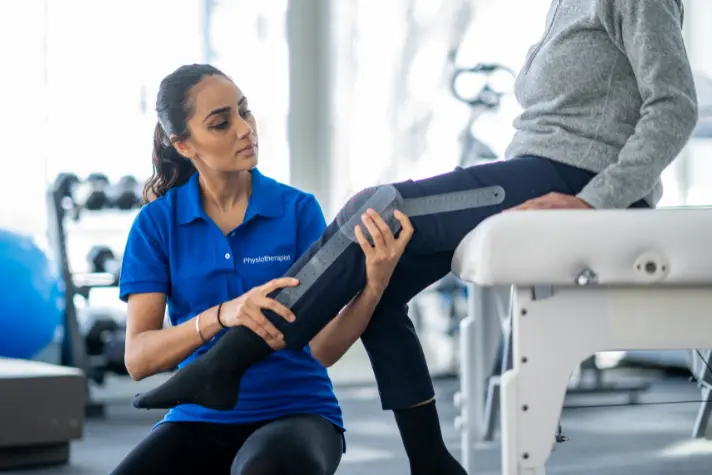
Insufficient awareness surrounds the risks inherent in modern work environments, often underestimating the potential dangers of sedentary office jobs. This misconception is far from reality.
The continuous utilization of technology and prolonged periods of inactivity lead to repetitive movements that significantly elevate the likelihood of experiencing Repetitive Strain Injuries (RSIs).
RSIs encompass a range of painful conditions affecting muscles, tendons, and nerves, with the capacity to substantially hamper productivity and overall well-being. Nonetheless, a repertoire of physiotherapy strategies, including exercises, stretches, ergonomic assessments, and self-care routines, exists to prevent, treat, and mitigate RSIs.
These approaches not only counteract RSIs but also encourage muscle flexibility, joint mobility, and enhanced postures (Verhagen et al., 2013). This article delves into physiotherapy techniques for averting and addressing repetitive strain injuries (RSIs) in professional settings.
It defines RSIs, underscores their impact on productivity and well-being, and sheds light on exercises, stretches, and ergonomic evaluations that foster muscle flexibility, joint mobility, and improved posture.
The importance of early detection, timely intervention, and self-care practices are emphasized for the pursuit of a productive and pain-free work life.
What are RSIs?

RSIs represent a collection of neuromuscular symptoms stemming from recurring movements or static postures that manifest over weeks to years. These injuries are categorized into RSIs Type I and Type II. RSIs Type I involves well-defined clinical conditions (e.g., carpal tunnel syndrome), while RSIs Type II entails “non-specific pain syndromes” lacking distinct anatomical foundations (e.g., focal dystonia).
Contrary to common misconceptions, RSIs are far from trivial health concerns. They can persist for weeks or months and have been linked to epidemics, exemplified by the 1980s RSI outbreak in Australia (Awerbuch, 2004). Furthermore, RSIs exhibit chronic, incapacitating symptoms and discomfort, often defying correlation with specific ailments.
RSI hurts productivity: its symptoms can directly impede the ability to perform tasks efficiently, and the arising need for extended breaks or time off work can disrupt workflows. RSIs can have a considerable impact as well on overall well-being. They can lead to chronic pain, reduced quality of life, and even psychological stress.
Strategies to Prevent and Treat RSIs in the Workplace

Exercises and Stretches
At a known Scarborough physiotherapy clinic, that frequently treats patients dealing with ongoing RSIs, many individuals have developed or are undergoing treatment for these conditions. To address these issues, they advocate for the importance of physical therapy.
This therapeutic approach involves exercises and stretching techniques that enhance muscle strength, flexibility, and blood circulation. This, in turn, reduces the risk of injury. Additionally, we emphasize the value of incorporating brief workday breaks as a preventive measure.
Moreover, specific postural exercises throughout the week are recommended to aid in RSI management. These exercises include Propped Knee Slides With Neck Rotation, Crab To Bridge, and Straight Arm scapular-only push-ups.
These targeted strengthening exercises, such as wrist flexion and forearm extension, are indispensable for maintaining muscular balance and alleviating stress. Together, these approaches underscore our commitment to comprehensive care for RSIs.
Optimal Workspaces Design
A pertinent strategy entails the design of ergonomic workspaces. This approach prioritizes ergonomics, which centers on crafting environments tailored to individual physical needs throughout the workday. A comfortable workspace inherently minimizes injury risk.
Ergonomic assessments serve as valuable tools, facilitating the evaluation of workstations, chairs, keyboards, and related devices to ensure proper alignment with the individual’s physique. Adjustments in chair height, screen positioning, and keyboard angle significantly alleviate strain on wrists, neck, and back.
Cultivating an Ergonomic Culture
It is important to note that ergonomic strategies do not include only the design of ergonomic workspaces: they also consist as well of culture, actions, and beliefs leading to properly disposing of the body during timework activities.
Poor posture is a major contributor to RSIs. It is important to maintain neutral spinal alignment, which reduces stress on the spine and surrounding muscles, to reduce the risk of RSIs. Knowledge and awareness are important here. Certain exercises, like shoulder blade retractions and pelvic tilts, aid in cultivating improved posture awareness.
The integration of fluid movements such as neck glides, wrist circles, and ankle pumps can amplify joint flexibility and counteract the rigidity that can arise from extended periods of immobility. Promoting both those exercises and the importance of good posture is important to develop an ergonomic culture in the workplace.
Prevention Strategies

Early detection is vital in managing RSIs effectively in the workplace. Paying attention to subtle signs of discomfort, such as tingling, numbness, or aching, is key to diagnose and control the condition on time.
If symptoms arise, seeking prompt medical attention and physiotherapy is critical. Physiotherapists can provide personalized treatment plans, including manual therapy, targeted exercises, and modalities like ultrasound or electrical stimulation.
The above-mentioned workplace ergonomic culture can contribute to prevention. It can promote many self-care practices as well, which are key to preventing and treating RSIs. Incorporating relaxation techniques, such as deep breathing and mindfulness, can reduce stress and muscle tension.
Regular breaks that include stretching and movement can prevent muscles from becoming overly fatigued. Moreover, maintaining a balanced diet and staying hydrated contribute greatly to overall well-being, supporting the body’s natural healing processes.
Conclusion
Repetitive Strain Injuries are a considerable challenge to productivity and well-being in workplaces. By adopting physiotherapy strategies focused on exercises and stretches, the design of optimal workspaces, the use of assessments, the implementation of ergonomic culture, and the promotion of self-care, individuals can effectively prevent and manage RSIs. A holistic approach, centered on both individual beliefs and practices, is adequate to improve workers’ well-being and increase productivity and performance levels using the designing of safe workspaces.
Contributed by:
HealthMax Physiotherapy Clinic is a leading healthcare provider located in the heart of the Greater Toronto Area. With a dedicated team of experienced physiotherapists and healthcare professionals, our clinic is committed to enhancing the well-being and quality of life of individuals in our community.
References
- Repetitive strain injuries AnnaleeYassi FRCPC – https://www.sciencedirect.com/science/article/pii/S0140673696072212
- Repetitive Strain Injuries of the Upper Extremity: Imaging of Tendon Pathology and Compressive Neuropathies – https://www-sciencedirect-com.ezproxy.uniandes.edu.co/science/article/pii/S0363018820301419?via%3Dihub
- Repetitive strain injuries: has the Australian epidemic burnt out? – https://onlinelibrary-wiley-com.ezproxy.uniandes.edu.co/doi/full/10.1111/j.1444-0903.2004.00640.x? sid=nlm%3Apubmed
- Chronic occupational repetitive strain injury. O’Neil BA, Forsythe ME, Stanish WD. Chronic occupational repetitive strain injury. Can Fam Physician. 2001 Feb;47:311-6. PMID: 11228032; PMCID: PMC2016244. https://www.ncbi.nlm.nih.gov/pmc/articles/PMC2016244/
- Verhagen, A. P., Bierma-Zeinstra, S. M., Burdorf, A., Stynes, S. M., de Vet, H. C., & Koes, B. W. (2013). Conservative interventions for treating work-related complaints of the arm, neck, or shoulder in adults. The Cochrane database of systematic reviews, 2013(12), CD008742. https://doi.org/10.1002/14651858.CD008742.pub2 Conservative interventions for treating work‐related complaints of the arm, neck, or shoulder in adults




